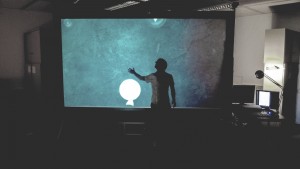The way we interact with technology has a huge impact on our cognitive processes. The interaction technique is one of the ways to influence the cognitive processes. Thus, different ways of interacting influences important factors such as recall or recognition of the displayed content.
Cognitive Effects of Interactive Public Display Applications
Many public displays are nowadays equipped with different types of sensors. Such displays allow engaging and persistent user experiences to be created, e.g., in the form of gesture-controlled games or content exploration using direct touch at the display. However, as digital displays replace traditional posters and billboards, display owners are reluctant to deploy interactive content, but rather adapt traditional, non-interactive content. The main reason is, that the benefit of such interactive deployments is not obvious. Our hypothesis is that interactivity has a cognitive effect on users and therefore increases the ability to remember what they have seen on the screen — which is beneficial both for the display owner and the user. In this paper we systematically investigate the impact of interactive content on public displays on the users’ cognition in different situations. Our findings indicate that overall memorability is positively affected as users interact. Based on these findings we discuss design implications for interactive public displays.
What People Really Remember – Understanding Cognitive Effects When Interacting with Large Displays
 This paper investigates how common interaction techniques for large displays impact on recall in learning tasks. Our work is motivated by results of prior research in different areas that attribute a positive effect of interactivity to cognition. We present findings from a controlled lab experiment with 32 participants comparing mobile phone-based interaction, touch interaction and full-body interaction to a non-interactive baseline. In contrast to prior findings, our results reveal that more movement can negatively influence recall. In particular we show that designers are facing an immanent trade-off between creating immersive and engaging user experiences and memorable content.
This paper investigates how common interaction techniques for large displays impact on recall in learning tasks. Our work is motivated by results of prior research in different areas that attribute a positive effect of interactivity to cognition. We present findings from a controlled lab experiment with 32 participants comparing mobile phone-based interaction, touch interaction and full-body interaction to a non-interactive baseline. In contrast to prior findings, our results reveal that more movement can negatively influence recall. In particular we show that designers are facing an immanent trade-off between creating immersive and engaging user experiences and memorable content.